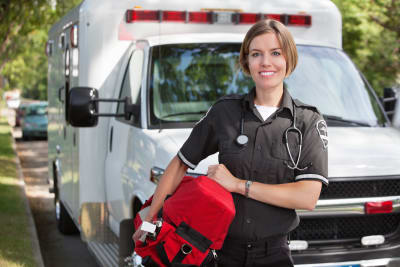A healthcare career is always a good idea. These occupations offer a chance to contribute to life-saving activities every day and provide a direct path, impressive salary, job security, an opportunity for growth, and a positive projection for the next decade.
One of the most appealing professions is the field of medical laboratory technology. As a medical lab tech, you can enjoy the above benefits and more.
If you’re interested in going through this route, then you must first have an in-depth overview of what the field entails, including what medical laboratory technicians do, their work environment becomes one, and the potential salary and job projection.
Thankfully, we discuss all of these in detail in the sections below.
Who is a Medical Laboratory Technician?
Medical laboratory technicians, or MLTs, are allied healthcare professionals whose role is to diagnose, treat, and prevent diseases through laboratory tests. A medical laboratory technician can work in clinical, diagnostic, or hospital settings, usually supervised by laboratory technologists and managers.
It is common to confuse medical laboratory technicians with medical technologists as both professions often go by the title “med techs,” there are indeed some overlaps between them, which are to perform tests and procedures in the laboratory ordered by physicians or surgeons.
The main difference between both fields is that medical laboratory technicians are often found performing more routine tests, while medical technologists may carry out complex lab procedures.
Duties & Responsibilities
Medical laboratory technicians often work with microscopes, setting up, calibrating, and maintaining the equipment along with similar ones such as cell counters. Below are some other duties and responsibilities of a medical laboratory technician:
- To test and analyze urine, blood, and tissue samples.
- To operate and maintain laboratory equipment.
- To make use of automated equipment in carrying out simultaneous analysis of multiple samples.
- To keep an accurate record of all test results by recording data from the tests and logging it onto the patient’s medical records.
- To discuss the data and results with physicians when the need arises.
- Prepare the appropriate laboratory reagents and solutions based on the specific tests.
Work Environment
Medical laboratory technicians can work in several environments and medical establishments. According to data from the Bureau of Labor Statistics, most laboratory technicians work in general medical and surgical hospitals where they can be employed by either the state government, local government, or a private body.
It is also common for MLTs to work in medical and diagnostics laboratories or the offices of physicians. While less common, they can also work in colleges, universities, and a host of educational establishments, along with outpatient care facilities.
A few things to note about working as an MLT is that you will often have to work full time, participating in shifts that include nights, holidays, and weekends. You should also be prepared to carry out a lot of repetitive motions, thanks to the nature of the job.
Specializing as a Medical Laboratory Technician
Medical Laboratory Technicians conduct tests and carry out procedures in the laboratory. But “laboratory” in this case, in general. Those who wish to do so may operate in specialized areas only.
Below are some of the most popular areas of specialization for a medical lab technician:
Blood bank Technicians - Blood bank technicians collect blood and prepare its components for diffusion.
Histotechncians - Histotechnicians are a clinical laboratory specialty for technicians who cut and stain tissue specimens for disease identification.
Cytotechnicians - Cytotechnicians use microscopes to examine slides of human cells.
How to Become a Medical Laboratory Technician
Below are the steps in pursuing a medical lab technician career.
Step 1: Possess a High Diploma
To begin your journey as a medical laboratory technician, you must first possess a high school diploma. It also helps that you focus on courses such as chemistry, biology, and mathematics during the program.
Step 2: Obtain an Associate’s Degree or Certificate
Once you have your high school diploma, the next thing to do is to obtain an associate’s degree. You may complete a 2-year clinical laboratory technician/ medical laboratory technician program. While this is the most popular approach, there are others.
It is also possible to become an MLT by completing a vocational program offered by a specialized vocational school or the armed forces.
Regardless of which path you choose, it is important to attend an accredited program and focus on both theoretical and laboratory aspects of the program.
Step 3: Become Certified
Certification is optional for all medical laboratory technicians; still, most people get them anyway. The reasons for this are that most employers tend to gravitate towards hiring certified technicians instead of those who are not.
The most popular certification bodies in the field are AAB and ASCP. To get certified by the AAB, you must possess an associate’s degree or complete 50 weeks of military training in a medical laboratory technician vocational program. You must also earn a passing grade in the MLT generalist exam and have three months of laboratory experience.
For the ASCP certification, candidates must have an associate’s degree, three years of experience on the job, or complete 50 weeks of military training in a medical laboratory technician vocational program.
Licensing requirements vary by state, with most states having relatively lax licensing requirements.
Step 4: Start Practicing
Once you earn your degree and become certified, you may practice as a medical laboratory technician. Hospitals, physicians’ offices, and medical laboratories are the best places to start looking for employment.
Salary & Career Outlook
According to the Bureau of Labor Statistics, medical laboratory technicians earned an average salary of $57,800 in 2021. Entry-level workers took home an average salary of $30,280, while the top earners made around $79,340.
Sorting by the establishment, those who worked in outpatient care centers earned the most with an average salary of $60,110, while those who worked in physicians’ offices earned the lowest average at $47,890.
The Bureau projects that the demand for medical laboratory technicians will grow by 7 percent between 2021 and 2031.




